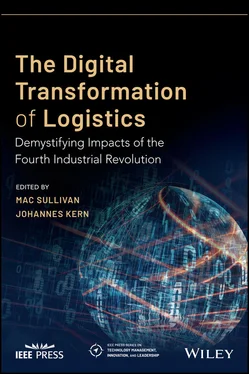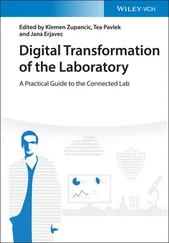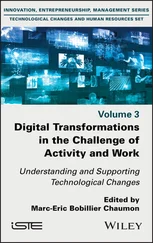4 Define what the IT department's purpose and goals are in hopes of providing a unique value proposition that will protect the company from competitors.
Zoom In
1 Examine areas where business meets technology that would be crucial to the success of the zoom out initiative and earmark resources to grow this.
2 Pick one near‐term initiative that would bolster the company's core value proposition. Ideally, this would be in an area that would have a measurable ROI from improving operational efficiency or selling.
3 Eliminate poor‐performing initiatives to free up resources to fund the above two points.
Executives will inherently tend to stray from above zoom out initiatives as urgent issues arise in the micro‐ and macroeconomic environments that they live in (Hagel and Brown 2018). Figure 1.4presents a set of digitalization goals based on a zoom out/zoom in approach.
This approach is just one of many strategies that could enable a company to understand all of the emerging technologies and then start their digitalization journey that will involve a change in customer experience, the acceleration of how they achieve their digital goals, and the best way to allocate their resources (McKinsey&Company 2018).
Change is not coming; it is already here. Electrification opened up a vast amount of new possibilities but was only made possible by fossil fuels that power it, smart innovative businesses that monetize it and drive adoption, engineers that tinker and enhance it, and lastly supportive governments that invest in the infrastructure to support it. 4IR technologies, such as AI, are opening up newfound opportunities and need many of the same inputs to make their potential a reality (Lee 2018). As noted above, there is a flood of startups and financial investors pouring into the supply chain and logistics market. Trade and shipment data is abundant in the databases of the logistics and shipping companies, as well as the governments who collect information when doing customs clearance. While traditionally governments are more reactive, efficiency gains driven by transportation that lead to more industrial outputs are being supported. The key element that the logistics industry may be missing is the talent to tie all these pieces together.

Figure 1.4 Digitalization goals.
The 4IR is not meant to be flipping of a switch but more the tinkering and thoughtful collaboration of a network of companies, individuals, and industries that collaborate to create a new vision for the future. By creating and spreading innovative ways to coordinate the global movement of goods, logistics companies can reduce costs and reduce waste that will help to create a more sustainable way of life for all those involved. Due to customer demand, competitive risk, and socioeconomic factors, logistics companies have no choice but to embrace digital transformation. By taking steps to audit and optimize a company or even a department within a company in terms of its technological capabilities, talent pool, and processes susceptible to automation, individuals can help to future‐proof the sustainability of their company.
Global economic stability and GDP growth have delayed the automation of white‐collar jobs to a lesser extent than blue‐collar jobs. Companies that had healthy balance sheets and content shareholders were less likely to have capital expenditures on expensive automated solutions as social ramifications were daunting and productivity gains and immediate ROI were not abundantly clear. More competition from new entrants and startups enabled by new systems integration solutions, as well as increasingly cheaper and more powerful cloud computing and processing speeds, will lower the barrier for hub economy companies to consider investing in the logistics industry. Profit per job derived from human input will decrease with higher labor costs, and increased transparency by marketplaces will continue to accelerate consolidation in the logistics market.
Talent shortages for documentation work will continue to be an issue in the logistics industry, and the industry will see the sun set on the era of information and pricing arbitrage. Investment in automating tasks whether through an API or RPA will outweigh the cost savings derived from outsourcing rote tasks to a lower‐cost location. Increased costs due to human error are currently negated by the complexity and number of variables dealing with different geographies, commodities, and customer types; however, technology is allowing for a wider view across multiple systems. While the operations of many logistics providers have remained unchanged for decades, there is an abundance of opportunities for improving efficiency through the use of technology, but company culture, organizational prioritization, and a strategy for change management need to be addressed first. Logistics companies will be forced down the digital transformation path, and those who start on it sooner will have a better chance to survive.
Technology has changed drastically since the start of the Third Industrial Revolution and can be difficult to keep up with. If unfamiliar with many of the emerging technologies presented in this chapter, then now is the time to start learning about them and considering how they could change the industry.
Technology is easy; changing people is the hard part. Convincing staff to adopt new technologies and onboarding stakeholders to use them will be one of the biggest challenges of digital transformation. Resistance to change is widespread among logistics providers, and overcoming this will take refined soft skills from IT departments and other interested parties.
The outcomes of digitalization will not be positive for everyone. There will likely be an increase in the adoption of automation in the coming years. For some employees, automation will free them of redundant tasks such as data entry, allowing them to focus on value‐added strategic tasks. Other employees could see their jobs eliminated.
Starting a digital transformation journey can be very difficult for logistics providers. The best place to start is by looking at the current state and trying to understand it holistically. Look at and identify current systems that can be improved; then decide what the organization can do on its own, and lean on suppliers and consultants to fill in the gaps.
1 Aouad, A. (2019). Uber freight is paying big to compete in the digital freight marketplace—99% of its revenue goes to carriers. Business Insider: 2019–2021. https://www.businessinsider.com/uber‐freight‐gives‐nearly‐all‐revenue‐to‐freight‐carriers‐2019‐6.
2 Bao, K., Sun, N., and Guo, E. (2018). Status of the Logistics Industry.
3 Bonacich, E. and Wilson, J. B. (2011) Getting the Goods: Ports, Labor, and the Logistics Revolution. Cornell University Press. https://books.google.com/books?id=R0EQk_0Ldd8C(accessed 15 March 2019).
4 Bose, N. (2019). Amazon Dismisses Idea Automation Will Eliminate all its Warehouse Jobs Soon ‐ Reuters. Reuters https://www.reuters.com/article/us‐amazon‐com‐warehouse/amazon‐dismisses‐idea‐automation‐will‐eliminate‐all‐its‐warehouse‐jobs‐soon‐idUSKCN1S74B9.
5 Brynjolfsson, E. and McAfee, A. (2014). The Second Machine Age: Work, Progress, and Prosperity in a Time of Brilliant Technologies. W. W. Norton https://books.google.com/books?id=PMBUAgAAQBAJ.
6 Bughin, J., Manyika, J., and Woetzel, J. (2016). MGI the Age of Analytics: Competing in a Data‐Drivel World, 126. http://www.mckinsey.com/mgi.
Читать дальше













